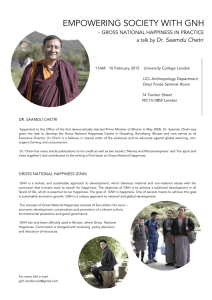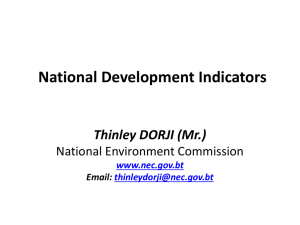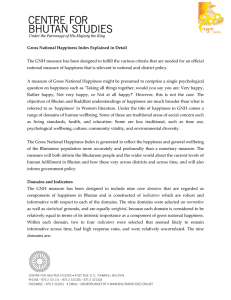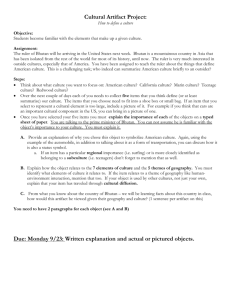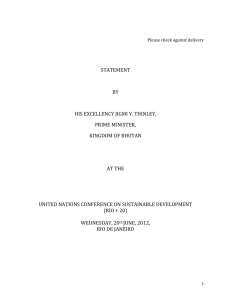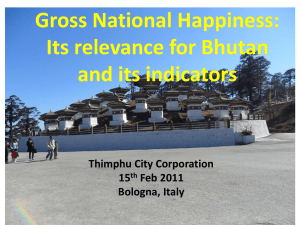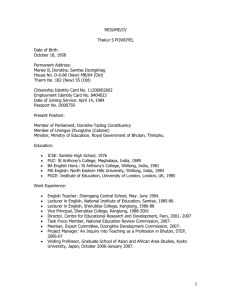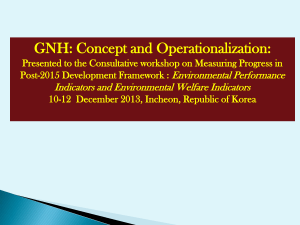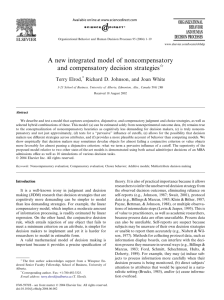Gross National Happiness and Indicators
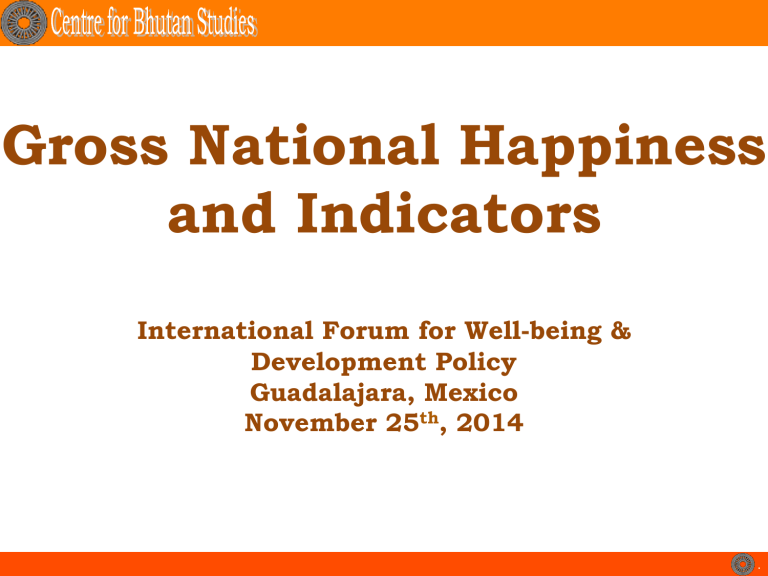
Gross National Happiness and Indicators
International Forum for Well-being &
Development Policy
Guadalajara, Mexico
November 25 th , 2014
.
Understanding GNH
Retrieved from http://i1.trekearth.com/photos/40040/bhutan-nature.jpg
Ø
Values
Ø
Goals
Ø
Indicators
Ø
Practice
.
Retrieved from http://www.jamesmorgan.co.uk/photo/bhutan/
Values
Inter-connectedness
Holistic
Balance
Sustainability
Retrieved from http://www.jamesmorgan.co.uk/photo/bhutan/
Goals
.
4 th King of Bhutan
“Gross National Happiness is more important than Gross National
Product.”
5 th King of Bhutan
“ … the beneficial development of human society takes place when material and spiritual development occurs side by side to complement and reinforce each other …”
.
Constitution of Bhutan 2008, Article 9:
“The State shall strive to promote those conditions that will enable the pursuit of Gross National
Happiness.”
.
Goal for GNH?
Improve conditions for v Good physical and mental health v High spirituality v Good education v Clean environment v Vibrant community v Strong and vibrant culture v Good governance v Decent standard of living v Work-life balance
.
Indicators
.
Objectives of GNH Indicators
• Setting an alternative framework for development
• Providing indicators to sectors to guide development
• Allocating resources
• Measuring people’s wellbeing and happiness
• Measuring progress over time
.
Living
Standards
Psychological
Wellbeing
Health
Ecological
Diversity and
Resilience
Community
Vitality
GNH Time Use
Education
Good
Governance
Cultural
Diversity and
Resilience
.
Artistic skills
• Weaving,
Embroidery,
Painting,
Carpentry,
Carving,
Sculpture,
Casting,
Blacksmithing,
Bamboo works,
Gold/ silversmith,
Masonry,
Leather works,
Paper making
Speak native language
Cultural
Diversity and
Resilience
Driglam
Namzha (code of etiquette and conduct)
• Importance
• Changes in practice
Cultural participation:
• Number of days spent in socio-cultural events in a year
.
Safety
• Having been a recent victim of crime
Donations (time & money)
• Proportion of household income donated
• Days of volunteering
Community
Vitality
Family
• Family care
• Wish you were not part of your family
• Argue too much
• Feel like a stranger in family
• Family are understanding
• Family are a real source of comfort
Community relationship
• Sense of belonging
• Trust neighbours
.
2006-07
1 st Pilot GNH survey
– 350 respondents interviewed
– 474 questions, 1000 variables
2007-08 2 nd Pilot GNH survey
– 950 respondents interviewed
– 289 questions, 800 variables
2010
First GNH survey
– 7,142 respondents interviewed
– 249 questions, 700 variables
.
Standard questionnaire v Open ended/Close ended v Simple wording v Questionnaire structure/layout
Method of application v Personal interviews
Pilot testing v Items variation v Meaning/translation v Redundancy v Scalability v Non-response
.
Living Standards
• Assets
• Housing
• Household per capita income
Psychological
Wellbeing
• Life satisfaction
• Positive emotions
• Negative emotions
• Spirituality
Health
• Mental health
• Self reported health status
• Healthy days
• Disability
Ecological
Diversity and
Resilience
• Ecological Issues
• Responsibility towards environment
• Wildlife damage (Rural)
• Urbanization issues
GNH
Index
Time Use
• Work
• Sleep
Education
Community
Vitality
• Donations (time & money)
• Community relationship
• Family
• Safety
Good Governance
• Gov’t performance
• Fundamental rights
• Services
• Political Participation
Cultural Diversity and Resilience
• Speak native Language
• Cultural Participation
• Artistic Skills
• Driglam Namzha
• Literacy
• Schooling
• Knowledge
• Value
.
GNH Indicators were selected for the
GNH Index according to:
1) Normative values
2) Statistical properties
3) Accuracy across time
4) Policy relevance
.
Weighting
v 9 domains are equally weighted v 33 major indicators, 2-4 per domains do not share equal weighting
.
Threshold
GNH index uses two kinds of thresholds:
1.
Sufficiency threshold 2.
Happiness threshold
Shows how much a person needs in order to enjoy ‘sufficiency’ – how much is enough, normally, to create a happiness condition.
Each of the 33 GNH indicators has a sufficiency threshold.
A person who enjoys sufficiency in 66% of weighted domains is considered happy.
.
How much is enough? is guided by… v International standards v National average v Normative and aspirational v Participatory meetings
.
Identifying who is happy according to GNH
.
.
Practice
.
Retrieved from http://www.jamesmorgan.co.uk/photo/bhutan/ .
Retrieved from http://www.tourism.gov.bt/about-bhutan/Economy
.
INTERNATIONAL CONFERENCE ON
GROSS NATIONAL HAPPINESS
NOVEMBER , 2015
THIMPHU, BHUTAN
ORGANISER:
CENTRE FOR BHUTAN STUDIES cbs@bhutanstudies.org.bt
www.grossnationalhappiness.com
THIMPHU, BHUTAN
CONTACT PERSON:
Conference Coordinator
TSHERING PHUNTSHO gortshompa07@gmail.com
.
